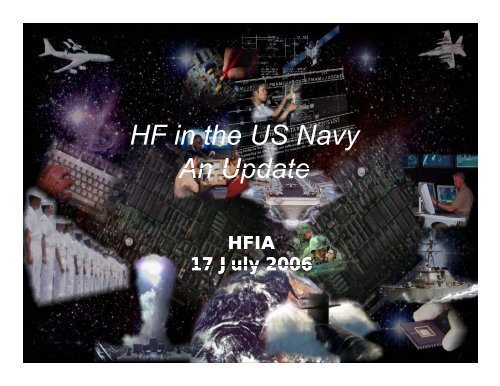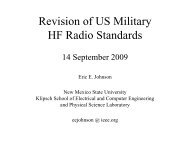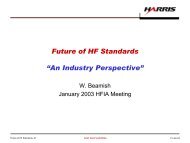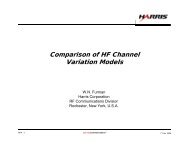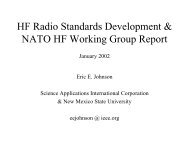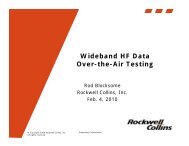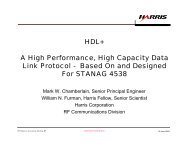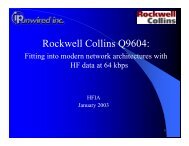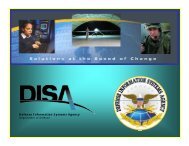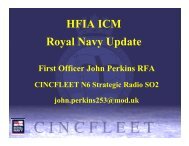HFIA-US Navy Status_071706v2
HFIA-US Navy Status_071706v2
HFIA-US Navy Status_071706v2
Create successful ePaper yourself
Turn your PDF publications into a flip-book with our unique Google optimized e-Paper software.
HF in the <strong>US</strong> <strong>Navy</strong>An Update<strong>HFIA</strong>17 July 2006Page 1<strong>HFIA</strong> 16 Jan ’03 (JLM)
Ongoing Initiatives High Frequency Data System– BFEM66– HFIP Mast Clamp Current Probe Shore Infrastructure Upgrade JTRSPage 2<strong>HFIA</strong> 16 Jan ’03 (JLM)
HFDS Relies on BFEM66 Today FY’04 – FY’06– Currently 195 ships fielded d with BFEM66 point to point system‣ Non-networked - stand alone‣ Still growing in number of Allied/Coalition partnerswho use BFEM66 for communication with <strong>US</strong> <strong>Navy</strong>afloat– Technology obsolescence management is necessary objectivein order to maintain Allied/Coalition interoperability the <strong>US</strong><strong>Navy</strong> afloat has today‣ Overlapping technology lifecycles across two (2)upgrade increments– Increment I: SMTP over HF (Battle Force E-Mail66)– Increment II: IPv6 over HF (S-5066)Page 3<strong>HFIA</strong> 16 Jan ’03 (JLM)
100BFEM 66 Performance: Service to the FleetDown Time ReportsAverage Data RatesPre-Set Modem Speeds for Shipboard Systems80EastIf Modem SNR = 24 SNR*60 WestWith Function = MIL110B MIL110B MIL110B-F MIL110B-F402002000 2002 2004 2006Interoperability Level:Int'l Partner NATO Coalition FMS/Direct VerifiedBelg 3 FMS YesCan 16 Direct YesFra 77 DirectGer 24 FMS YesItal 58 DirectJap 22 FMS YesNeth 6 Direct Yes via NATOOman 15 Direct Yes via UKSpn 1 DirectUK 60 Direct Yes<strong>US</strong> 182At Datarate = 4.8 Kbps 9.6Kbps 12.8Kbps 19.2Kbps253K Worddocument 12.2 minutes 10.9 Minutes 7.0 Minutes 3.0 minutes259K PDF File 15.2 minutes 13.7 minutes 10.00 minutes 71 7.1 minutesOperationalandadministrativetraffic toincludeemails andattachments* SNR = Signal to Noise Rating on modem front panelInformationCharacteristicsRequirementsSending NodeAfloatplatforms,shore sitesboth U.S. andAllied/Coalition.Jointaircraft/landbasedvehicles asappropriate.Afloatplatforms,shore sitesboth U.S. andAllied/Coalition.Jointaircraft/landbasedvehicles asappropriateReceiving NodeFormatData packets,formatted inaccordancewith STANAG5066 in amodulatedwaveformcomplyingwith STANAG4539/MIL-STD 188-110BTimelinesVariable. Intwo stationnet, 100KBmessage inless than 5mins.Page 4<strong>HFIA</strong> 16 Jan ’03 (JLM)
Internet Protocol over HF (HFIP) Effort endorsed by CNO in April 2001 Developed by SSC SD in Linux OS with NC3Acollaboration - based on STANAG 5066 Upgrade of BFEM66 for ship to ship HF TCP/IP– Support most IP-based apps traffic SSBorISBupto192KBPS19.2 – 5066 App. F waveforms Interconnection with other off-ship RF systemsPage 5<strong>HFIA</strong> 16 Jan ’03 (JLM)
HFIP Experience Dec 02 – Three ship at sea trial Aug 03 to Aug 05 – E2C Compatibility tests andtrial deployment May 04 to Dec 04 – Various demonstrations andexercises with ships and shore sites Dec 05 – Trident Warrior 05. Demonstrationinvolving 3 ships, 2 aircraft and shore site Jun 06 – Trident Warrior 06. Demonstrationinvolving 3 <strong>US</strong>N ships and 2 RAN ships Jul 06 – Ongoing tests with SSN utilityPage 6<strong>HFIA</strong> 16 Jan ’03 (JLM)
Battle Force Email 66 CapabilitiesGrowth Plan in HFDS– FY06‣ Integrate HF-IP Design and connect to secure LANinfrastructures– Advances HF pathway capability toward hands-freeoperation at a network appliance E-Mail Internet Relay Chat Environment Secure FTP transfers NetMeeting Distributed Database Replication– Implement in air, ground and afloat environments Diverse Token Ring connection topologies Multiple platform connections and bridging across nodes‣ Broaden scope of HFDS to include shore and aircraft– Successful demonstration ti in theatre t and in more diversearchitectures continuesPage 7<strong>HFIA</strong> 16 Jan ’03 (JLM)
HFDS is listed as #2 Interoperability“Need” in <strong>US</strong> <strong>Navy</strong>FY06 - FY09– Developing the integration and operationunderpinnings necessary for afloat, aircraft,shore comms‣ CONOPS, ILS, IP addressing schema, etc.– Moving (as the rest of the DoD is) toward IPv6‣ Add HF-IP utility into airborne platforms‣ Add HF-IP into shoreside platforms– Combining HFDS with non-HF systems toimprove information transfer among ships inLOS/ELOS proximityMove toward IP over HF in a Joint/Allied Interoperabilityenvironment will set the rate of authorized improvements in theU.S. <strong>Navy</strong>Page 8<strong>HFIA</strong> 16 Jan ’03 (JLM)
Mast Clamp Current Probe17.5”x17.5”x6.5” (100Lbs.)17.5”x17.5”x10.5” (110LBs)Mounting kit and bellyband<strong>US</strong>S Roosevelt StubMastPage 10<strong>HFIA</strong> 16 Jan ’03 (JLM)
Mast Clamp Current Probe <strong>Status</strong>– CONOPS successfully demonstrated in 1998 and2000– New construction DDGs being outfitted– Fleet modernization requirements being addressedPage 11<strong>HFIA</strong> 16 Jan ’03 (JLM)
Shore Infrastructure Upgrade Shore HF requirements still pretty muchrestricted to MPA support Most shore sites being upgraded to <strong>US</strong>AFScope Command standards pending turn overto <strong>US</strong>AF for O&M– Some dual use sites will remainPage 12<strong>HFIA</strong> 16 Jan ’03 (JLM)
HF Transition to JTRS FY’09 - FY’10– Assessing business case offered by ALE in HF-IP tokenring environment over legacy SSB capability‣ With ALE controller or new ALE radio functions– Continue to measure and accomplish dove-tailing withJTRS requirements‣ JTRS will support all HF waveforms/protocols usedin the <strong>US</strong> <strong>Navy</strong> today.– Mil-Std-188-110B appendix F– STANAGs 5066 and 4529– HF ALE Mil-Std-188-141B– ATC HF Data LinksPage 13<strong>HFIA</strong> 16 Jan ’03 (JLM)
Summary HF Data (IP Based) use for allied/coalitionnaval interoperability is proving reliable andefficient <strong>US</strong> <strong>Navy</strong> continues to search for Higherspeed modems for increasing HF mediumoperational utility HFDS used with Military IT architectures isaddressing the U.S. <strong>Navy</strong>’s needs for dataspeed, hands-free utility and HF networking Goals within the <strong>Navy</strong>’s HF programs arecompatible with JTRS implementationPage 14<strong>HFIA</strong> 16 Jan ’03 (JLM)
BackupPage 15<strong>HFIA</strong> 16 Jan ’03 (JLM)
DefinitionsA Token Ring network is a local area network (LAN) in which all computers are connected ina ring, mesh or star topology and a bit- or token-passing scheme is used in order to preventthe collision of data between two computers that want to send messages at the same time– Very briefly, here is how it works:‣ When a computer has a message to send, it inserts a token in an empty frame (this may consistof simply changing a 0 to a 1 in the token bit part of the frame) and inserts a message and adestination identifier in the frame.‣ The frame is then examined by each successive workstation. If the workstation sees that it isthe destination for the message, it copies the message from the frame and changes the tokenback to 0.‣ When the frame gets back to the originator, it sees that the token has been changed to 0 andthat the message has been copied and received. It removes the message from the frame.‣ The frame continues to circulate as an "empty" frame, ready to be taken by a workstation whenit has a message to send.– The Token Ring protocol (IEEE 802.5) is the second most widely-used protocol on local areanetworks after Ethernet.The HF-IP Token scheme is used within a wireless “Bus” network topology and “Multi-cast”connection state.– In the bus network topology, every HF-IP workstation is connected to a single frequency channelcalled “the bus” . Multicast (1) communication is systematically handed off between a single senderand multiple receivers on the HF-IP network.‣ Therefore, in effect, each workstation is directly connected to every other workstation in thenetwork.(1) Together with anycast and unicast, multicast t is one of the packet types in the Internet t ProtocolVersion 6 (IPv6). Multicast is supported through wireless data networks technology.Page 16<strong>HFIA</strong> 16 Jan ’03 (JLM)


